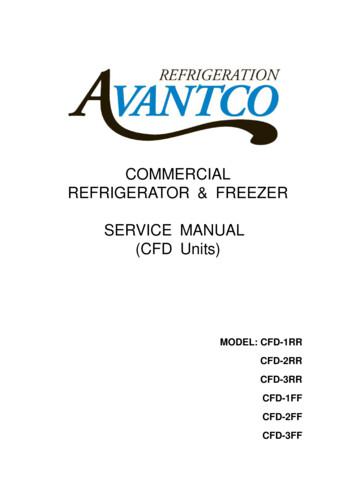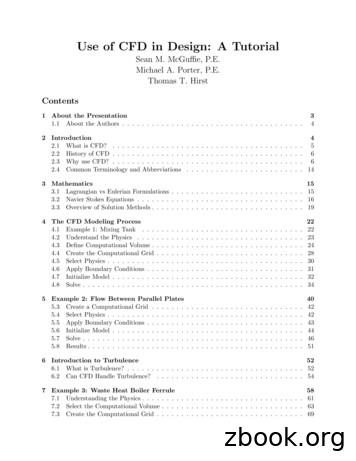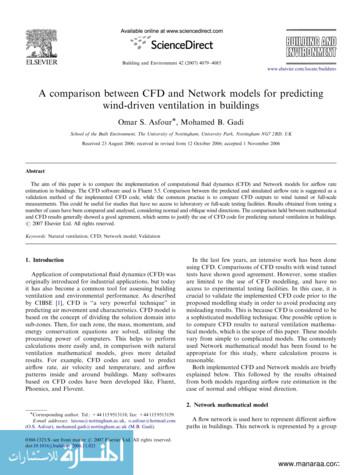Design And Flow Through CFD Analysis Of Enclosed Impeller
International Journal of Engineering Research & Technology (IJERT)ISSN: 2278-0181Vol. 3 Issue 7, July - 2014Design And Flow Through CFD Analysis OfEnclosed ImpellerAshish J. Patel1 , Bhaumik B. Patel21M.E (Machine Design) Student, Mechanical Engineering,Kalol Institute of Technology and Research Centre, Kalol, Gujarat, India2Assistant Professor, Mechanical Engineering Department,Kalol Institute of Technology and ResearchCentre, Kalol, Gujarat, India,Gujarat Technological University2. OBJECTIVETo Perform Design and Flow through CFD analysis of theEnclosed impeller in Ansys software with modification ininlet and outlet blade angles of the impeller and number ofblades of the impeller to investigate the changes in head aswell as efficiencies.3. LITERATURE REVIEWE.C. Bcharoudis et. al. [1] have contributed to reveal theflow mechanisms inside centrifugal impellers and studiedperformance by varying outlet blade angle. They observeda gain in head more than 7 % with increase in outlet bladeangle from 20 degree to 45 degree.K. M. Pandey et. al. [2] have performed two-dimensionalsteady numerical analysis for centrifugal pumps withimpeller blades 7, 8 and 9 using Ansys Fluent 6.3 softwarefor inlet diameter 80 mm and outlet diameter 168 mm at2500 rpm rotational speed also to investigate the changes inhead as well as efficiencies with the increase of bladenumber.S.Rajendran et. al. [3] have performed the simulation of theflow in the impeller of a centrifugal pump. The flowpattern, pressure distribution in the blade passage, bladeloading and pressure plots are discussed.IJERTAbstract -- The Impeller of Centrifugal Pump is one of mostCritical Component to be designed. The Flow throughCentrifugal Pump impeller is three dimensional and fullyturbulence model. The present work describes the design andflow through CFD analysis of enclosed impeller of thecentrifugal Pump. The model of impeller was generated usingSOLIDWORKS and analyzed in ANSYS (Workbench) FluidFlow (CFX). The numerical solution of the discredited threedimensional, incompressible Navier-Stokes equations over anunstructured grid is accomplished with an ANSYS-CFX. Thedesign of enclosed impeller is done by using various inputdata, the value of head is determined by theoretical as well asCFD value. The CFD analysis of Enclosed impeller has beencarried out at various inlet and outlet blade angles of theimpeller and number of blades of impeller to investigate thechanges in head as well as efficiencies.Keywords – Impeller Design, Solid Works, CFD, PressureDistribution, Efficiency1. INTRODUCTIONA pump is a machinery or device for raising, compressingor transferring fluid. A fluid can be gasses or any liquid.Pumps are one of the most often sold and used mechanicaldevices and can be found in almost every industry. Pumpsalone do not create pressure; they only displace fluid,causing a flow. Adding resistance to flow causes pressure.Pumps fall into five major groups: direct lift, velocity,buoyancy and gravity pumps.A centrifugal pump is a kinetic device. Liquid entering thepump receives kinetic energy from the rotating impeller.The centrifugal action of the impeller accelerates the liquidto a high velocity, transferring mechanical (rotational)energy to the liquid. That kinetic energy is available to thefluid to accomplish work. The centrifugal pumps act as areversed of an inward radial flow reaction turbine.Centrifugal pumps consist of a set of rotating vanes,enclosed within a housing or casing, used to impart energyto a fluid through centrifugal force.IJERTV3IS0711984. Design of Enclosed ImpellerFor design calculation, the design ParametersCROMPTON SRAM-400 Pump are taken as follows:ofTable 4.1 Design Data for PumpSr.NoParametersValue1Flow rate0.5 m3 /s2Head30 m3Pump Speed735 rpm4Gravitational Acceleration9.81 m/s 25Density of Sewage Water1050 kg/m3www.ijert.org(This work is licensed under a Creative Commons Attribution 4.0 International License.)1366
International Journal of Engineering Research & Technology (IJERT)ISSN: 2278-0181Vol. 3 Issue 7, July - 2014 The design steps are as follows: [4]1.Calculation of Shape Number (Nsh):Nsh 2.10 3 n Q3(g h)4Calculation of Power (P): Power input to the pump, Pc is given by,ρ g H QPC ηovCalculation of power to be supplied by the MotorPCm ,Pcm Molf PCWhere Molf is overloading factor.Calculation of Shaft Diameter (dsh ):dsh 4.5.316 Pcmω π τtorCalculation of Hub Diameter (dh):dh 1.4 dshCalculation of Eye Diameter (de ):de 4.5 6.U2 3 QnImpeller inlet diameter (Di ):Di 1.05 to 1.02 de7. Tangential velocity at inlet (U1 ):Calculation of number of Vanes (Z): 6.5*(D2 D1)*sin(β1 β 2 ) (D2 -D1) Z 210. Calculation of Suction Pipe Diameter (DS ):Cm1 CO ,Where Cm1 Flow velocity at inlet3But, CO 0.06 to 0.08* Qn211. Inlet width at the impeller (B1 ):Cm 22tan β 2 ((Cm 22tan β 2)2 gHb1 )1 2Hydraulic efficiency ηhy,ηhy 1 0.42(log 𝑑 𝑒 0.172 )2Theoretical Head Hb1 ,Hb1 HηhyFlow velocity at outlet, Cm2 0.8 to 0.9Cm1U 60. Similar stepsSubstituting the value of U2, Do 2π ncan be applied for obtaining the outlet width of blade(B2) as for inlet width (B1).Cm1)u1π Di nU1 609. Calculation of inlet vane angle (β1 ):β1 tan 1 (8.IJERT3.The flow area just inside the vane passage at theinlet, isФ1 Q′A1 Cm1 Vane contraction factor at the inlet,t1Ф1 t1 Su1Where, t1 Pitch of vanesSu1 Peripheral vane thickness at the inletπ Dit1 Z Peripheral Vane thickness at inlet,S1Su1 Sinβ1Where, S1 Vane thickness at inlet 5 to 8 mm.A1B1 π Di12. Vane angle at the outlet (β2 ):Nshβ2 35 813. Calculation of outlet diameter (DO ):14. Relative velocity at inlet and outlet (Vr ):Cm1,2Vr1,2 Sinβ1,2The Calculated Parameters are as below:Sr.Parameters1Impeller inlet diameter2Impeller outlet diameter3Impeller inlet width4Impeller outlet width5Blade thickness6Inlet vane angle7Outlet vane angle8Number of vanesValue402 mm630 mm120 mm70 mm15 mm14020045. CFD ANALYSIS OF ENCLOSED IMPELLERComputational Fluid Dynamic is a branch of fluidmechanics that uses numerical methods and algorithms tosolve and analyze problem that involve fluid flows.IJERTV3IS071198www.ijert.org(This work is licensed under a Creative Commons Attribution 4.0 International License.)1367
International Journal of Engineering Research & Technology (IJERT)ISSN: 2278-0181Vol. 3 Issue 7, July - 2014Step2. Our CFD Analysis method is Cavity Patten so wehave to create Cavity model of above impeller.Step3. Save above Cavity model in *. IGES Format forImporting into ANSYS Workbench Mesh Module forMeshing.Figure 7.2 Cavity Model of ImpellerIJERTFigure 5.1 CFD methodologyStep4. Import above Cavity model in ANSYS WorkbenchMesh Module.6. BOUNDARY CONDITIONSCentrifugal pump impeller domain is considered as rotatingframe of reference with a rotational speed of 735 rpm. Theworking fluid through the pump is water at 27 0C. k-εturbulence model with turbulence intensity of 5% isconsidered. Inlet and outlet Pressure and mass flow rate of0.5 m3 /s are given as boundary conditions. Threedimensional incompressible N-S equations are solved withAnsys-CFX Solver.7. PROCEDURE OF CFD ANALYSISStep1. 3D Model of Impeller is generated inSOLIDWORKS 2009 as per above given Drawing.Figure 7.3 Cavity model of impeller in ANSYS WorkbenchStep5. Meshing of ImpellerMeshing Type: 3DType of Element: TetrahedralFigure 7.1 3D Model of ImpellerIJERTV3IS071198www.ijert.org(This work is licensed under a Creative Commons Attribution 4.0 International License.)1368
International Journal of Engineering Research & Technology (IJERT)ISSN: 2278-0181Vol. 3 Issue 7, July - 2014Step9. Define Heat Transfer and Turbulence model.No. of Nodes: 46403No. of Elements: 241146Figure7.4 Meshed Model of Impeller CavityFigure 7.7 Heat Transfer and Turbulence ModelStep6. Save above model in *.CMDB Format for importinginto ANSYS CFX Pre.IJERTStep7. Import above .CMDB File in ANSYS CFX Pre.Heat Transfer Model: Total EnergyTurbulence Model: k- epsilonWhere k is the turbulence kinetic energy and is defined asthe variance of the fluctuations in velocity. It hasdimensions of (L2 T-2); for example, m2 /s 2 .ε is the turbulence eddy dissipation (the rate at which thevelocity fluctuations dissipate), as well as dimensions of kper unit time (L2 T-3) (e.g., m2 /s 3 ).The k-ε model introduces two new variables into thesystem of equations. The continuity equation is then: ρ ρU 0 tand the momentum equation becomes ρU ρU U μef f U t P ′ μef f U T BFigure 7.5 Impeller Cavity in ANSYS CFX PreStep8. Define Water Particle Domain.Domain Type: FluidDomain Fluid: Water 5 mm ParticleDomain motion: RotatingDomain RPM: 735 rpmRotating about: Y AxisStep10. Define Hub as a Rotating WallWall Roughness: Smooth WallHeat Transfer: AdiabaticFigure 7.8 Hub as a Rotating WallStep11. Define Shroud as a Rotating Wall.Figure 7.6 Water Particle DomainIJERTV3IS071198www.ijert.org(This work is licensed under a Creative Commons Attribution 4.0 International License.)1369
International Journal of Engineering Research & Technology (IJERT)ISSN: 2278-0181Vol. 3 Issue 7, July - 2014Step14. Define Solver Control Criteria.Figure 7.9 Shroud as a Rotating WallStep12. Define inlet for ImpellerDefine inlet mass Flow Rate: 0.5 m3 /sStatic Frame to Total Temperature: 300 KFigure 7.12 Solver Control CriteriaNumber of Outer loop iteration: 100Convergence Criteria:Residual Target: 1e-4Step15. Run the AnalysisIJERT7.2 Results of Analysis:Inlet Angle: 140Outlet Angle: 200Figure 7.10 Inlet for ImpellerStep13. Define Outlet for ImpellerDefine Outlet mass Flow Rate: 0.5 m3 /sFigure 7.13 Velocity ContourFigure 7.13 shows minimum velocity is 1.035*101 m/s andmaximum velocity is 4.051*101 m/s.Figure 7.11 Outlet for ImpellerIJERTV3IS071198www.ijert.org(This work is licensed under a Creative Commons Attribution 4.0 International License.)1370
International Journal of Engineering Research & Technology (IJERT)ISSN: 2278-0181Vol. 3 Issue 7, July - 2014Figure 7.16 Outlet Pressure ContourFigure 7.14 Inlet Pressure ContourIJERTFigure shows pressure contours at inlet, it helps one inidentifying the maximum and minimum pressure at theinlet when the fluid comes in contact with the blade. Hereminimum inlet pressure is 1.625*105 Pascal and maximuminlet pressure is 1.752*105 Pascal.Here minimum outlet pressure is 5.401*105 Pascal andmaximum outlet pressure is 5.426*105 Pascal. Figure 4.29shows inlet pressure contour at inlet blade angle 140 andoutlet blade angle 180 at which fluid leave the impeller andpump get maximum efficiency (approximately 96%).Figure 7.15 Outlet Pressure ContourFigure shows that pressure at outlet of impeller, beforeentering the casing. Here minimum outlet pressure is4.825*105 Pascal and maximum outlet pressure is4.925*105 Pascal.Head Here minimum inlet pressure is 1.613*105 Pascal andmaximum inlet pressure is 1.690*105 Pascal. Figure 4.30shows inlet pressure contour at inlet blade angle 140 andoutlet blade angle 180 which indicate maximum pressure atwhich fluid comes in contact with the impeller and thehead is maximum(approximately 36 m).Head Outlet Pressure Inlet Pressureρ g (5.426 e5 - 1.69 e5)/(1050 * 9.81) 36.27 mOutlet Pressure Inlet Pressureρ gTable 7.1 Generated Head at VariousBlade Angles4.925e5 1.752 e51050 9.81Head 30.804 m7.3 Modification in Inlet and Outlet Blade Angles ofImpellerHere we took various inlet and outlet blade angles to showpressure distribution at inlet and outlet of impeller beforeentering the casing. Among them the best result was takenand discussed below.Inlet Angle: 140Outlet Angle: 180IJERTV3IS071198Figure 7.17 Inlet Pressure ContourInlet 6.1295.94www.ijert.org(This work is licensed under a Creative Commons Attribution 4.0 International License.)Head(m)33.52ƞSr.No(%)90.861371
International Journal of Engineering Research & Technology (IJERT)ISSN: 2278-0181Vol. 3 Issue 7, July - 2014100Efficiency806040200Figure 7.21 Inlet Pressure Contour at Number of Blades 4Generated HeadFigure7.18 Generated Head Vs. EfficiencyIJERT7.4 Modification in Number of Blades ofImpellerFigure 7.22 Outlet pressure Contour at Number of Blades 4Figure 7.19 Outet Pressure Contour at Number of Blades 3Figure 7.23 Outlet pressure Contour at Number of Blades 5Figure 7.20 Inlet Pressure Contour at Number of Blades 3IJERTV3IS071198www.ijert.org(This work is licensed under a Creative Commons Attribution 4.0 International License.)1372
International Journal of Engineering Research & Technology (IJERT)ISSN: 2278-0181Vol. 3 Issue 7, July - 2014REFERENCES[1] E. C. Bacharoudis, A. E. Filios, M. D. Mentzos and D. P. Margaris,“Parametric Study of a Centrifugal Pump Impeller by Varying theOutlet Blade Angle”, The open Mechanical Engineering Journal,2008, 2, 75-83.[2] K. M. Pandey, A. P. Singh and Sujoy Chakraborty, “Numericalstudies in effect of Blade number variations on performance ofCentrifugal Pumps at 2500 rpm”, Journal of EnvironmentalResearch and Development, Vol.6 No. 3A, Jan-March 2012.[3] S.Rajendran and Dr.k.Purushothaman, “Analysis of a centrifugalpump impeller using ANSYS-CFX”, International Journal ofEngineering Research & Technology (IJERT) Vol. 1 Issue 3, May –2012, ISSN: 2278-0181.[4] Prof. S. Kumaraswamy. “Databook for design of CentrifugalPumps”. Center for Industrial Consultancy and Sponsored Research,IIT Madras.[5] Sujoy Chakraborty, Kishan Chaudhary, Prasenjit Dutta,“Performance prediction of Centrifugal pumps with variations ofblade number”, Journal of science and Industrial research, vol.72,June 2013, pp. 373-378.[6] Weidong zhou, Zhimei Zhao, T. S. Lee, and S. H. Winoto,“Investigation of flow through Centrifugal Pump Impellers usingComputational Fluid Dynamics”, International Journal of RotatingMachinery, 9(1): 49-61, 2003.[7] C. P. Kothandaraman, R. Rudramoorthy, “Fluid Mechanics AndMachinery (Second Edition)”, Handbook, New Age International (P)Limited, Publishers.[8]G.K. Sahu., Pumps, New Age International Publishers, First edition,2000.[9] John D. Anderson Jr., Joris Degroote, G erard Degrez, Erik Dick,“Computational Fluid Dynamics an Introduction”, Handbook,Springer.IJERTFigure 7.24 Inlet pressure Contour at Number of Blades 5Figure7.25 Number of Blades Vs. HeadCONCLUSIONThe CFD predicted value of the head at the designed flowrate is approximately H 30.804 m. There is 8.04% ofdifference between the theoretical head and the predictednumerical head.From the CFD analysis of centrifugal pump impeller, themaximum generated head is 36.27m at inlet blade angle140 and outlet blade angle 180 respectively and the pumpefficiency is approximately 96%.With modification in number of blades of impeller, it isconclude that head is decreases at number of blades 3 and5. So number of 4 blade impeller is suitable for this pump.IJERTV3IS071198www.ijert.org(This work is licensed under a Creative Commons Attribution 4.0 International License.)1373
Define inlet mass Flow Rate: 0.5 m. 3 /s Static Frame to Total Temperature: 300 K . Figure 7.10 Inlet for Impeller . Step13. Define Outlet for Impeller Define Outlet mass Flow Rate: 0.5 m. 3 /s . Figure 7.11 Outlet for Impeller . Step14. Define Solver Control Criteria. Figure 7.12 Solver
refrigerator & freezer . service manual (cfd units) model: cfd-1rr . cfd-2rr . cfd-3rr . cfd-1ff . cfd-2ff . cfd-3ff . 1 table of contents
430 allocation to elianto cfd o&m 20,577.32 440 allocation to trillium west cfd o&m 27,267.00 450 allocation to west park cfd o&m 70,008.22 460 allocation to festival ranch cfd o&m 177,790.54 480 allocation to tartesso west cfd o&m 27,809.17 481 allocation to anthem sun valley cfd o&
CFD Analysis Process 1. Formulate the Flow Problem 2. Model the Geometry 3. Model the Flow (Computational) Domain 4. Generate the Grid 5. Specify the Boundary Conditions 6. Specify the Initial Conditions 7. Set up the CFD Simulation 8. Conduct the CFD Simulation 9. Examine and Process the CFD Results 10. F
performing CFD for the past 16 years and is familiar with most commercial CFD packages. Sean is the lead author for the tutorial and is responsible for the following sections: General Procedures for CFD Analyses Modeling Turbulence Example 3 - CFD Analysis
downstream of the grid. The CFD results and experimental data presented in the paper provide validation of the single-phase flow modeling methodology. Two-phase flow CFD models are being developed to investigate two-phase conditions in PWR fuel assemblies, and these can be presented at a future CFD Workshop. 1. INTRODUCTION
EFD, CFD, and UA laboratories. EFD labs were improved and UA was introduced. Complementary CFD labs were also introduced using an advanced research code modified for limited user options. From 1999 to 2002, the research CFD code was replaced by the commercial CFD software (FLUENT) and refinements were made and
The CFD software used i s Fluent 5.5. Comparison between the predicted and simulated airflow rate is suggested as a validation method of the implemented CFD code, while the common practice is to compare CFD outputs to wind tunnel or full-scale . Both implemented CFD and Network models are briefly explained below. This followed by the .
A.2 Initial Interactive CFD Analysis Figure 2: Initial CFD. Our forward trained network provides a spatial CFD analysis prediction within a few seconds and is visualised in our CAD software. A.3 Thresholded and Modified CFD Analysis Figure 3: Threshold. The CFD is thresholded to localise on























